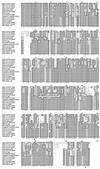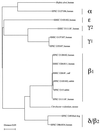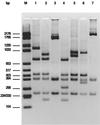Typing of intimin genes in human and animal enterohemorrhagic and enteropathogenic Escherichia coli: characterization of a new intimin variant
- PMID: 10603369
- PMCID: PMC97102
- DOI: 10.1128/IAI.68.1.64-71.2000
Typing of intimin genes in human and animal enterohemorrhagic and enteropathogenic Escherichia coli: characterization of a new intimin variant
Abstract
Enteropathogenic Escherichia coli (EPEC) and enterohemorrhagic E. coli (EHEC) produce the characteristic "attaching and effacing" (A/E) lesion of the brush border. Intimin, an outer membrane protein encoded by eae, is responsible for the tight association of both pathogens with the host cell. Several eae have been cloned from different EPEC and EHEC strains isolated from humans and animals. These sequences are conserved in the N-terminal region but highly variable in the last C-terminal 280 amino acids (aa), where the cell binding activity is localized. Based on these considerations, we developed a panel of specific primers to investigate the eae heterogeneity of the variable 3' region by using PCR amplification. We then investigated the distribution of the known intimin types in a large collection of EPEC and EHEC strains isolated from humans and different animal species. The existence of a yet-unknown family of intimin was suspected because several EHEC strains, isolated from human and cattle, did not react with any of the specific primer pairs, although these strains were eae positive when primers amplifying the conserved 5' end were used. We then cloned and sequenced the eae present in one of these strains (EHEC of serotype O103:H2) and subsequently designed a PCR primer that recognizes in a specific manner the variable 3' region of this new intimin type. This intimin, referred to as "epsilon," was present in human and bovine EHEC strains of serogroups O8, O11, O45, O103, O121, and O165. Intimin epsilon is the largest intimin cloned to date (948 aa) and shares the greatest overall sequence identity with intimin beta, although analysis of the last C-terminal 280 aa suggests a greater similarity with intimins alpha and gamma.
Figures



References
-
- Agin T S, Cantey J R, Boedeker E C, Wolf M K. Characterization of the eaeA gene from rabbit enteropathogenic Escherichia coli strain RDEC-1 and comparison to other eaeA genes from bacteria that cause attaching-effacing lesions. FEMS Microbiol Lett. 1996;144:249–258. - PubMed
Publication types
MeSH terms
Substances
LinkOut - more resources
Full Text Sources
Other Literature Sources
Molecular Biology Databases

